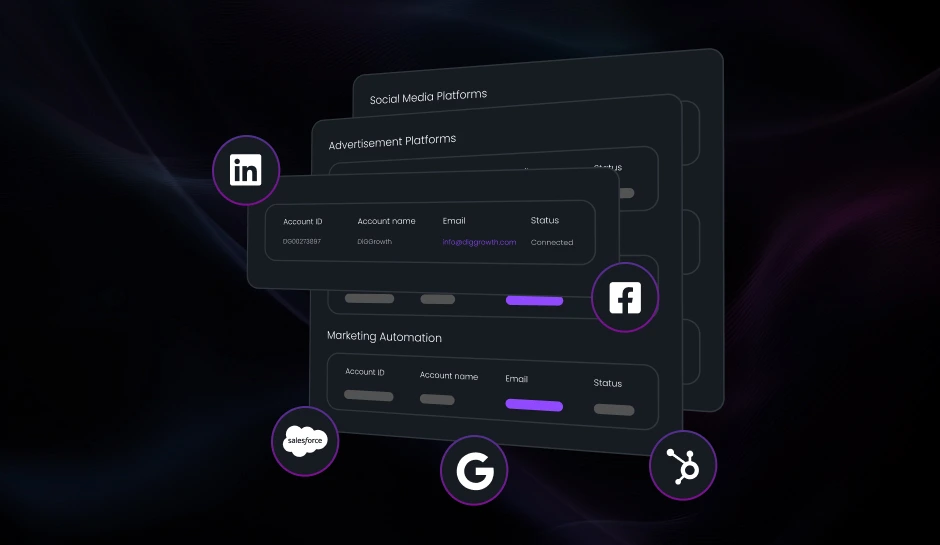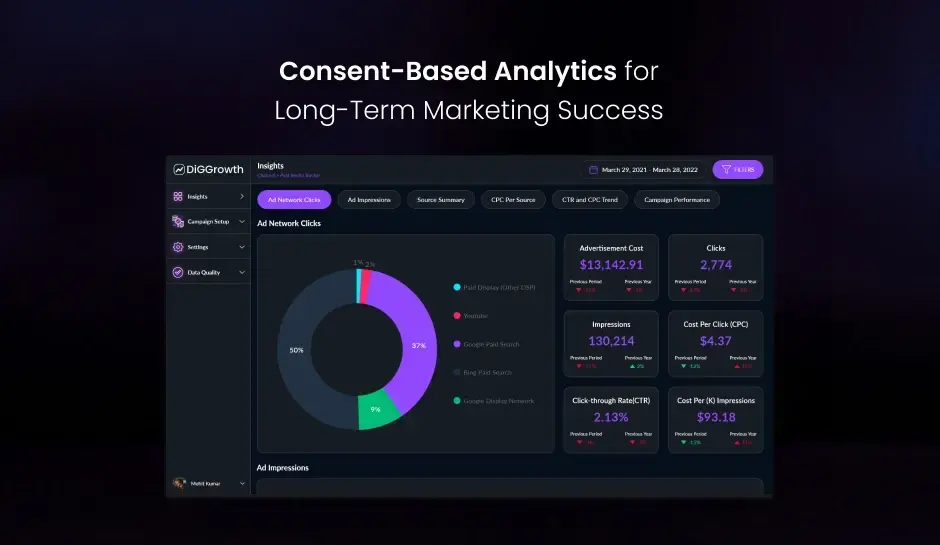
The role of analytics in strategic marketing
Marketing analytics guides decision-makers through campaign complexities, optimizing efforts using key metrics like CAC, CLTV, and ROI. Tools like DiGGrowth help interpret data for informed strategies, driving business growth. Mastering analytics transforms marketing from mere spending to revenue generation, enhancing competitiveness and success in the digital landscape.
Analytics shape strategy development, allowing teams to pivot and rapidly adapt to market changes and consumer responses. Leveraging this data translates into informed decisions, optimizing marketing initiatives for performance and return on investment.
As businesses dive deep into the ocean of available data points, the ability to extract actionable insights from a webpage becomes the bedrock of competitive advantage. With each click, view, and interaction, analytics offers a clearer vision of the path to success, ensuring every marketing move is a step toward achieving business objectives.
Deconstructing Metrics: A Closer Look at Campaign Success
Assessing the efficacy of marketing campaigns demands a meticulous approach to evaluating the right metrics. Diligent scrutiny of these metrics transforms raw data into actionable insights, guiding future strategies and optimizing budget allocations.
CAC (Customer Acquisition Cost)
The customer acquisition cost metric encapsulates the cost of acquiring a new customer. To calculate CAC, divide the sum of all marketing and sales expenses by the number of new customers acquired within the same period. Rapid comprehension of this metric aligns marketing spending with customer value, ensuring resources are aptly deployed.
CLTV (Customer Lifetime Value)
A pivotal metric, Customer Lifetime Value (CLTV), manifests the total revenue a business can expect from a single customer throughout their relationship. To calculate CLTV, the average purchase value is multiplied by the number of transactions and the retention period. Grasping CLTV empowers businesses to foster strategies that enhance the longevity and profitability of customer relationships.
ROI (Return on Investment)
Return on Investment is the performance measure employed to evaluate the efficiency of an investment or to compare the efficiency of several investments. Within marketing, ROI is calculated by subtracting the marketing expenses from the sales growth, dividing by the marketing cost, and multiplying by 100 to get the percentage. A thorough analysis of ROI across various channels unveils the most lucrative avenues for investment, enabling marketers to allocate funds with precision.
Deploying the metrics of CAC, CLTV, and ROI offers a trifecta of analytical power. Tracking these measures not only elucidates the cost-effectiveness of acquisition strategies but also the enduring value of customers and the overarching financial impact of marketing initiatives. Harnessing these metrics steers firms toward data-driven decision-making, attuning efforts closely to the business’s financial goals.
Pro Tip- Regularly monitor CAC, CLTV, and ROI to identify the most cost-effective marketing strategies, optimize budget allocation, and maximize customer value for long-term success.
Value-Driven Metrics: AOV and Market Analysis
Delving into Average Order Value (AOV) and Market Share offers insights into a business’s financial health and competitive standing. AOV directly reflects consumer spending habits on each transaction, calculated by dividing total revenue by the number of orders.
Businesses amplify AOV and, thus, overall profitability by deploying strategies such as product bundling, upselling, and incentivizing higher spending through loyalty programs or strategic discount thresholds.
By scrutinizing customer purchasing patterns, companies can tailor these strategies to align with consumer behavior, increasing the chances of elevating the AOV effectively. It becomes particularly powerful when leveraged alongside real-time data analytics, yielding actionable insights that help refine marketing and sales initiatives for heightened customer spending per order.
In parallel, Market Share emerges as a pivotal performance metric, portraying a company’s sales in the context of its industry’s total sales. Firms track gains or losses in market share to gauge overall market performance and strategic positioning. This metric informs whether a company is thriving, maintaining, or declining in its competitive landscape.
Fueled by market share data, competitive analysis equips businesses with the intelligence needed to make informed decisions. Understanding where a company stands among its competitors helps identify market trends, gauge the effectiveness of marketing efforts, and direct resource allocation for maximum impact.
- AOV shines a spotlight on customer spending habits.
- Increasing AOV necessitates tailored strategies for customer behavior.
- Market Share benchmarks a business within the broader industry context.
- Data on market share cultivates insight for strategic planning and industry competitiveness.
Pro Tip- Leverage real-time data analytics to monitor AOV and Market Share. Use insights to tailor marketing strategies, optimize sales initiatives, and gain a competitive edge in your industry.
Funnel Analytics for Improving Customer Journey
Decoding funnel analytics sharpens the understanding of how prospects move through the sales process. The goal is to identify where they convert or fall off, enabling marketers to optimize the customer journey effectively. Monitoring funnel conversion rates offers a clear picture of the effectiveness of the marketing funnel and provides actionable insights to enhance performance.
Funnel Conversion Rates
Examining funnel conversion rates reveals the proportion of potential customers who take a desired action. A streamlined conversion rate across the funnel signals an effective customer journey. Conversely, a decline at any stage necessitates immediate action to rectify possible impediments.
Mapping and Optimizing Each Funnel Stage
Marketers must scrutinize user behavior and interaction with content to map and optimize each funnel stage. Adjusting various elements, such as landing page calls to action and customer touchpoints, advances the effectiveness of each stage. Optimization relies on rigorous testing and data analysis to continuously refine the customer journey.
Best Practices for Funnel Analysis
Adopting best practices for funnel analysis includes a comprehensive examination of customer interactions and feedback. Strategies for improvement comprise redesigning navigation paths, personalizing marketing messages, and expediting response times to inquiries. These methods foster a smoother transition from initial awareness to a final purchase decision.
Organic Traffic
Organic traffic is a testament to the strength of SEO and content marketing efforts. Analyzing this traffic shows how well content resonates with target audiences and the efficacy of search engine strategies. Increasing organic traffic typically correlates with improved search engine rankings and heightened brand awareness.
Assessment of SEO and Content Marketing Efforts
An in-depth assessment of SEO and content marketing efforts centers on the visibility and value of produced content. Evaluation encompasses keyword performance, backlink profiles, and content shareability. This review assists in pinpointing strengths and areas that require targeted improvement.
Calculating the ROI of Organic Traffic
Calculating the return on investment (ROI) of organic traffic involves measuring the gains from this channel against the resources devoted to optimizing it. Accurate ROI computation hinges on tracking the right metrics, such as lead generation and conversion rates. A positive ROI signifies a successful content marketing strategy, while a low ROI might indicate the need for strategic revisions.
Pro Tip- Regularly analyze funnel conversion rates to identify drop-off points. Use A/B testing to optimize each funnel stage and leverage organic traffic insights to refine SEO and content strategies for better customer engagement and higher ROI.
Putting Metrics into Action: Performance Improvement
Once marketing analytics metrics are in hand, actionable insights can transform strategies and elevate performance. Interpretation goes beyond mere numbers as marketers delineate cause and effect, correlating specific tactics with variations in metrics. This understanding paves the way for informed decisions and fine-tuning marketing efforts to optimize reach, engagement, and conversion.
Consider case studies where analytics fueled remarkable turnabouts. A tech company, for example, may notice a significant drop in website traffic post-interface redesign. An in-depth analysis could reveal that loading times have increased, bouncing potential customers. This organization may reclaim and boost its user base by reverting to a simplified design.
Several platforms facilitate this process. Google Analytics provides deep insights into website performance, social media tools offer engagement and sentiment analysis, and CRM software mines customer data for patterns in behavior. Integrating these systems allows for a comprehensive overview of marketing effectiveness.
Subsequently, marketers can employ A/B testing to compare outcomes from different campaigns or content variations. The insights gained inform future iterations, ensuring a process of continual refinement. Actions include revising keyword strategies, restructuring campaigns across channels, or personalizing content to drive deeper audience connections.
Through sustained attention to analytics, businesses ensure ongoing performance improvement and stay agile in a rapidly evolving digital landscape. As data becomes the cornerstone of marketing strategies, those who master its interpretation and application gain a substantial edge over the competition.
Pro Tip- Regularly use A/B testing and real-time analytics to adapt strategies quickly. Integrate tools like Google Analytics and CRM software for a holistic view, and make data-driven decisions to refine your campaigns for continuous improvement.
Mastering the Pulse of Marketing Success Through Analytics Metrics
Marketers rely on a constellation of analytics metrics to gauge successes, understand failures, and steer strategies in the most profitable directions. Metrics like conversion rates, engagement rates, customer lifetime value, and many others serve as a compass for business growth. A dynamic and comprehensive approach to analyzing these figures translates into more informed decisions, targeted campaigns, and, ultimately, stronger business outcomes.
When done consistently, measurement and analysis act as the engine room of marketing strategy, powering the ship through competitive waters. Without these insights, companies might navigate blindly, missing opportunities and failing to capitalize on their data. Harnessing the power of analytics ensures that every move is calculated and every campaign is launched with precision, thus maximizing return on investment.
Analytics helps cut through the noise and elevates marketing from a cost center to a revenue generator. Businesses that adeptly manage and interpret their marketing data are more likely to achieve sustained success while adapting to market shifts and consumer behavior. With advanced tools and platforms, such as Google Analytics, the wealth of data at one’s fingertips is immense and, if leveraged properly, immensely valuable.
Key Takeaways
- Key marketing metrics such as Customer Acquisition Cost (CAC), Customer Lifetime Value (CLTV), and Return on Investment (ROI) play a crucial role in shaping data-driven strategies, optimizing marketing efforts, and aligning them with business objectives.
- Integrating and customizing Google Analytics can provide deep insights into user behavior, traffic sources, and conversion rates, allowing marketers to effectively refine strategies and improve website performance.
- Share of Voice (SOV) reflects a brand’s market presence and influences customer perception. Understanding and optimizing Cost Per Acquisition (CPA) helps refine targeting and budget allocation, making marketing efforts more efficient.
- Regular analysis and application of metrics ensure ongoing optimization of marketing campaigns. Employing tools like A/B testing and funnel analytics can guide marketers in adjusting tactics to achieve sustained growth and competitive advantage.
Need assistance tracking key marketing analytics metrics?
Just write to us at info@diggrowth.com and we’ll get back to you.
Ready to get started?
Increase your marketing ROI by 30% with custom dashboards & reports that present a clear picture of marketing effectiveness
Start Free Trial
Experience Premium Marketing Analytics At Budget-Friendly Pricing.

Learn how you can accurately measure return on marketing investment.
Additional Resources
Integrating Data from Different Channels for a Holistic View of Your Marketing Performance
Who's your ideal customer? Where do they come...
Read full post postGet Your Channels to Play Nice: Integrated Data for Smarter Marketing
If you’re a savvy marketer, you’re living in...
Read full post postConsent-Based Analytics for Long-Term Marketing Success
As marketers, we want our customers to perceive...
Read full post post Richa Bhardwaj
Richa Bhardwaj  Sameer Pawar
Sameer Pawar 

